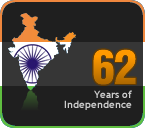’’A labyrinth, a city of palaces, an open gutter, a landscape of domes, an anarchy, a press of people, a choke of fumes, a whiff of spices.’’
The story of Delhi is about survival - time and again, Delhi was ransacked and razed to nothing, yet it rose again, for which legend gives due to the invisible Djinns that have made Delhi their residence and protect it, and the curse that whoever rebuilt it would lose the city. The flavor of myth overshadows all aspects; past and present, making Delhi seem as fabulous as the Baghdad of Arabian Nights.
The forces that shaped Delhi over a 1000 years and beyond, leave tokens scattered around, some prominently visible as tourist landmarks. Yet others are unmarked ruins, their significance escaping passers-by. Still others are masked by conversion to govt. offices and hospitals. It is curious how many such exist undiscovered, leaving the city a still-fresh archaeological dig site. The city is vivacious in its soul.
While we occasionally still whine about the colonial influence on our culture, the reverse India Effect on the former ruler is deeper. But the modern day truth is how much of that baggage has been shed, and how little it is remembered. Delhi’s history has two predominant faces to it - the wild frontier feel, during the times of early Muslim invaders from the North and the early British presence, with its opportunities of rapid advancement, and violent ends. The second is the decay, self-indulgence and cultivated debauchery of late Mughal Empire. The Twilight Period seems the lowest point, between the two massacres and sackings of Delhi, one by Nadir Shah of Persia (when he made off with the fabled Peacock Throne) and the Sepoy Mutiny of 1857, after which the British destroyed a number of irreplaceable monuments in a petty display of vengeful spirit. Power shifts however were never easy or civilized at any time- the intrigues of the royal family during the Shahjahan-Aurangzeb period are colorful and gossipy.
May be the terror attacks deemed as acts of extreme contempt but Its DELHI. Where violence is no stranger and extreme violence on a mass scale seems to visit with cyclical regularity. Tyrannical rulers like Tughlaq, massacres by invaders like Nadir Shah, the Partition (the largest forced mass migration in history) that changed the demographics of Delhi completely, the Sepoy Mutiny, the 1984 riots after the death of Mrs. Gandhi. What does living on thin ice constantly, in such extreme hazard to life and property does to human beings. Does life return to its primitive essentials, or turn escapist? With the fear of losing all in the next riot, strangely there is more clinging to materialism, not less.
It’s a city which does not follow a single language mannerism. Neither the regional contrite. It’s just as proud as the capital should be and as royal as Nothing has changed since mughal rulers. What makes it more interesting is that it’s not economy which derives the place after it has been ransacked, shaken and stirred but the brave face it has kept to pull itself up time and again.
So may it be Hijbul Mujahidin or SIMI ,terror can take newer names. It may be the city of Djinns and jinxed to rebuild itself every few decades. You can only deface the edifice but cannot mar the regalia.
PS: with help from "City of Djinns" by William Dalrymple





2 comments:
our immune systems have today build a strong defense around themselves.. to withstand any blow..
the society has also come of age.. to keep moving.. coz the cost of pausing is very high
Its not just a brave face.Its neither an anti paranoia syndrome.Its the worst way to test but for all those who pass they know their souls and to be proud of it
Post a Comment